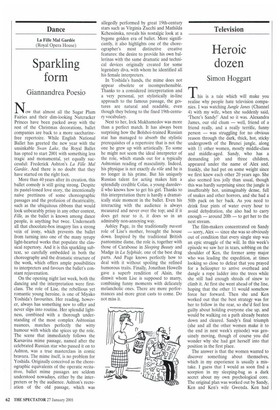La File Mal Gardee (Royal Opera House)
Sparkling form
Giannandrea Poesio
Now that almost all the Sugar Plum Fairies and their dim-looking Nutcracker Princes have been packed away with the rest of the Christmas decorations, ballet companies are back to a more saccharinefree repertoire. While English National Ballet has greeted the new year with the unsinkable Swan Lake, the Royal Ballet has opted to start 2001 with something less tragic and monumental, yet equally successful: Frederick Ashton's La Fille Mal Gardee. And there is no doubt that they have started on the right foot.
More than 40 years after its creation, this ballet comedy is still going strong. Despite its pastel-toned love story, the intentionally naive prettiness of some choreographic passages and the profusion of theatricality, such as the ubiquitous ribbons that would look unbearably prissy in any other context, Fille, as the ballet is known among dance people, is anything but twee. Underneath all that chocolate-box imagery lies a strong vein of irony, which prevents the ballet from turning into one of the many syrupy light-hearted works that populate the classical repertory. And it is this sparkling subtext, so carefully embedded in both the choreography and the dramatic structure of the work, which offers ample possibilities to interpreters and favours the ballet's constant rejuvenation.
On the opening night last week, both the dancing and the interpretation were firstclass. The role of Lise, the rebellious yet romantic young heroine, is one of Miyako Yoshida's favourites. Her reading, however, always has something new to offer and never slips into routine. Her splendid lightness, combined with a thorough understanding of the most complex Ashtonian nuances, matches perfectly the witty humour with which she spices up the role. The scene that immediately follows the Karsavina mime passage, named after the celebrated Russian star who passed it on to Ashton, was a true masterclass in comic bravura. The mime itself, is no problem for Yoshida. Originally conceived as the choreographic equivalents of the operatic recitativos, ballet mime passages are seldom understood nowadays, either by the interpreters or by the audience. Ashton's recreation of the old passage, which was
allegedly performed by great 19th-century stars such as Virginia Zucchi and Mathilda Kchessinska, reveals his nostalgic look at a bygone golden era of ballet. More significantly, it also highlights one of the choreographer's most distinctive creative features: the desire to provide his own ballerinas with the same dramatic and technical devices originally created for some legendary diva, with whom he identified all his female interpreters.
In Yoshida's hands, the mime does not appear obsolete or incomprehensible. Thanks to a considered interpretation and a very personal, yet stylistically in-line approach to the famous passage, the gestures are natural and readable, even though they belong to the fixed 19th-century vocabulary.
Next to her, Irek Mukhamedov was more than a perfect match. It has always been surprising how the Bolshoi-trained Russian star has managed to absorb the stylistic prerequisites of a repertoire that is not the one he grew up with artistically. To some he might not seem the ideal interpreter of the role, which stands out for a typically Ashtonian reading of masculinity. Indeed, his physique is not exactly du role and he is no longer in his prime. But his uniquely Russian talent for acting makes him a splendidly credible Colas, a young daredevil who knows how to get his girl. Thanks to this interpretation there is hardly a dramatically stale moment in the ballet. Even his interacting with the audience is always measured and never over the top; and if it does get near to it, it does so in an admirably non-annoying way.
Ashley Page, in the traditionally travesti role of Lise's mother, brought the house down. Inspired by the traditional British pantomime dame, the role is, together with those of Carabosse in Sleeping Beauty and Madge in La Sylphide, one of the best drag parts. And Page knows perfectly how to deal with it without spoiling the refined humorous traits. Finally, Jonathan Howells gave a superb rendition of Alain, the dimwit whom Use is supposed to marry, combining funny moments with delicately melancholic ones. There are more performances and more great casts to come. Do not miss it.






















































































 Previous page
Previous page